We’ve come through the dark night in Vienna to a brighter morning. Vocally, one might say today’s post shifts the dynamics and perhaps shapes a livelier melody as we walk in the footsteps of Wolfgang Amadeus Mozart and Ludwig van Beethoven. For me, the excitement was almost palpable.
Mozart – an exceedingly brief biography.
As you should have concluded from my visit to Zentralfriedhof, Vienna has played a significant part in the development of the Western classical music tradition. The music produced by the composers in Section 32B alone would set a solid foundation for anyone interested in listening to and learning about this music and the top of that list would certainly feature the man baptized Johannes Chrysostomus Wolfgangus Theophilus Mozart whom the world came to know by the name Wolfgang Amadeus Mozart. (It was from my great uncle Theophile, by the way, that my parents drew the first initial of my name.)
Mozart was born in Salzburg on 7 January 1756. His sister Maria Anna (called Nannerl) was the only other surviving child (of seven) of Leopold and Anna Maria and was about four and a half years old at his birth. Like his sister, Wolfgang was a musical prodigy. By the time he was the same age Nannerl was when Wolfgang was born he had nearly mastered playing the harpsichord and he began composing under his father’s supervision soon thereafter by age five.
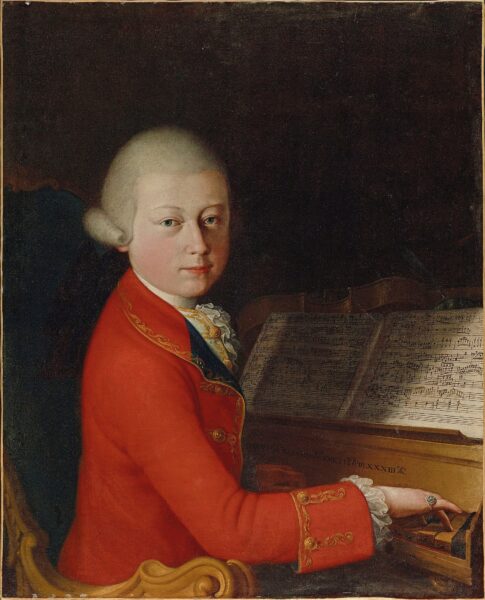
[Young Mozart from Wikimedia Commons – Public Domain.]
(Leopold was also a composer of some note in the 18th century.) Leopold first presented him to the imperial court at Vienna in 1762 and the following year embarked with both Wolfgang and Nannerl on a three year tour across Europe that included extended stays in Paris and London and the requisite appearances before the royals in those cities.
Mozart composed his first symphony (K 16 – Symphony Number 1 in Eâ™ major) at age eight. Three years later in 1767, he produced his first opera, Apollo et Hyacinthus, which was three acts and had a Latin libretto.
After he left the employment of the Archbishop of Salzburg in 1777, Mozart set out on his own traveling to Augsburg, Mannheim, Paris, and Munich in search of employment. Two incidents that deeply affected him occurred at this time. While in Mannheim, he met and fell in love with Aloysia Weber but when he set off on the rest of his journey, she appeared to forget him and, when next they met showed, no interest in him.
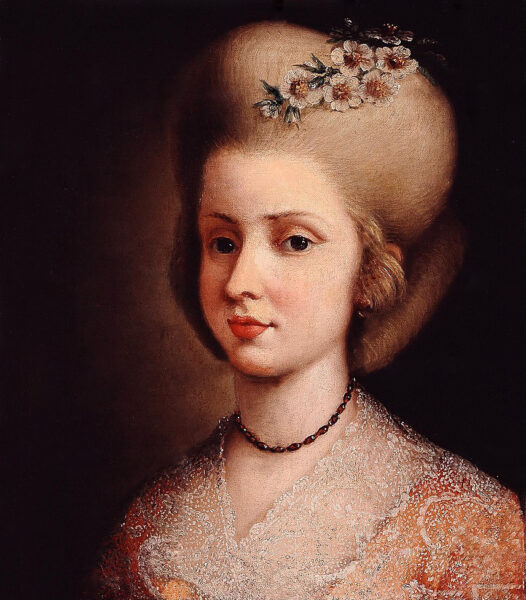
[Aloysia Weber from Wikimedia Commons – Public Domain.]
She later married Joseph Lange. The Weber’s were a well known musical family (all four of the sisters were singers and Carl Maria von Weber was her first cousin). Aloysia was a soprano who became her family’s main means of support after her father died suddenly and unexpectedly soon after the family had moved to Vienna from Mannheim. Struggling to make ends meet, the Webers also took in boarders one of whom was W A Mozart. Mozart, perhaps through the contrivance of Madame Weber eventually fell in love with and would marry Aloysia’s sister Constanze on 4 August 1782.
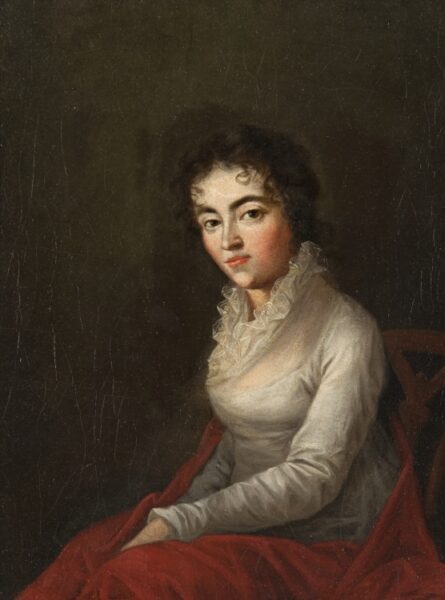
[Constanze Weber from Wikimedia Commons – Public Domain.]
But first, still seeking permanent employment, Mozart traveled to Paris in March 1778. He was accompanied by his mother with whom the young composer had an exceptionally close relationship. Anna Maria fell ill and died on 3 July that year. (His letters to his sister – quotes from which I would see in Salzburg – reveal a piteously distraught young man.)
Ultimately, Mozart returned to Vienna where he began teaching piano to the daughters of rich families. This was a period of great fecundity for Mozart and he began producing work at a furious pace. In the seven years from 1781-1788, he created some of his greatest piano concertos and other masterpieces in every form and genre.
Although Mozart had moved his family outside of central Vienna to Alsergrund (where we would see a performance of The Marriage of Figaro at the Volksoper Tuesday night), he also traveled extensively in the last three years of his life likely trying to improve his financial situation. The Austro-Turkish War, that began in 1788, was devastating the Austrian economy, significantly undermining the popularity of Emperor Joseph II who was among Mozart’s champions, and made it difficult for the Mozarts to support themselves in the manner to which they’d become accustomed.
In 1791 life seemed to be returning to normal. Mozart was again dazzlingly productive – completing the last of his 27 piano concertos, his final string quintet, the clarinet concerto, and a pair of operas (The Magic Flute and La Clemenza di Tito) among more than a score of other works. Of course there was the famous Requiem that was unfinished at the time of his death at 12:55 a.m. on 5 December 1791.
Mozart in the Morning.
Our group convened in the lobby and set out on a walking tour of central Vienna with the first highlight being a stop at 5 Domgasse that is preserved as the Mozart Museum and is one of at least 12 places Mozart lived in Vienna. (It’s possible that financial issues prompted these frequent moves but he might also have had other motivations. A passage from this 1788 letter to his father suggests another motive, “A fellow of mediocre talent will remain a mediocrity, whether he travels or not; but one of superior talent (which without impiety I cannot deny that I possess) will go to seed if he always remains in the same place.”))
En route to Domgasse we passed Cafe Frauenhuber

outside of which is a plaque stating that in 1788, the year it was founded by the personal chef to Maria Theresia, Mozart conducted a Pastorale composed by Handel and where Beethoven performed a quintet for four wind instruments and piano in 1797. We also passed the building at Rauhensteingasse 8 –
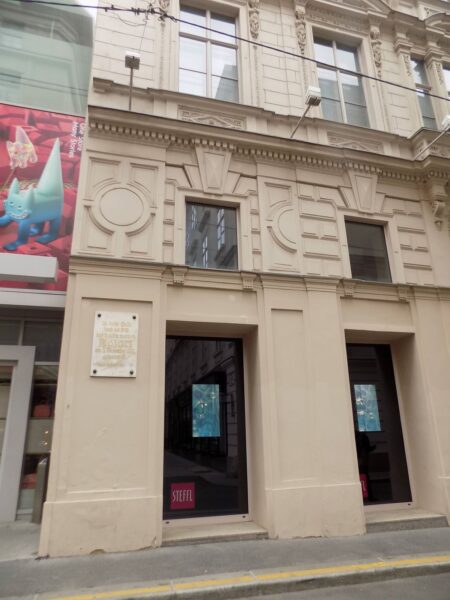
the location of Mozart’s death. That building is long gone. The marker by the door was installed in the 1920s.
(Let me dispel another myth or two about Mozart’s death – perpetuated to a degree by the film Amadeus.
First and foremost, Antonio Salieri wasn’t present at Mozart’s death though there’s some possibility that he visited the family during Mozart’s illness. According to an 1825 letter written by Sophie Heibel, Constanze’s younger sister, she and Constanze were there as was Mozart’s student Franz SĂĽssmayr with whom the dying Mozart was discussing the unfinished Requiem. There might have been a priest to administer last rites and Missus Weber might also have been present. But not Salieri. Several paintings such as this one by Hermann Kaulbach
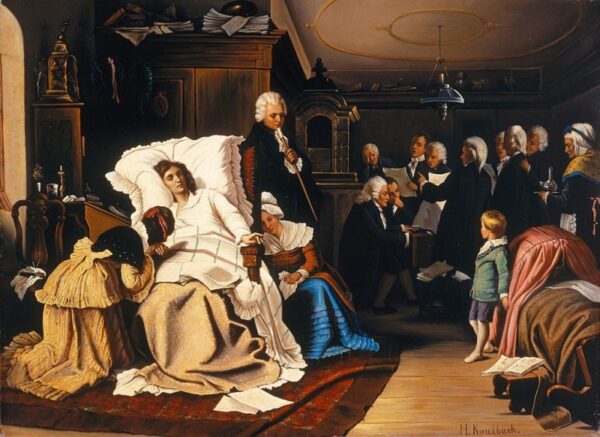
[From Wikimedia Commons – Public Domain.]
likely romanticized the actuality.
Mozart wasn’t poisoned. He first fell ill in Prague in September where he nevertheless conducted the premiere of Die Zauberflöte. He rallied but by the beginning of November had again fallen ill and there’s some evidence that he told Constanze then that he was soon to die and must have been poisoned. This was reported as his cause of death in a German newspaper a week or so later. As for Salieri’s supposed confession shortly before he died that he had poisoned Mozart, while there’s evidence to counter it {his two nurses, Gottlieb Parsko and Georg Rosenberg, as well as his family doctor Joseph Röhrig, attested that he never said any such thing}, there’s none to support it. There’s also evidence that Salieri had some form of dementia when he died at age 75.
So what caused Mozart’s death at such a young age? In truth, it remains a mystery. In an interview for newspaperalum Music historian Robert Greenberg notes, “According to his death certificate, Mozart died of “heated military fever” which was 18th century for ‘haven’t a clue.’ A contemporary newspaper claimed that he died of ‘dropsy of the heart,’ a swelling of the body due to water retention as a result of kidney failure. So, kidney failure has also been blamed for Mozart’s death, a failure that would have been brought on by a streptococcal infection, viral hepatitis, or some other viral illness. According to Doctor Peter J Davies in the Journal of the Royal Society of Medicine (1983), Mozart died from Henoch-Schonlein syndrome, ANOTHER secondary illness brought on by a viral infection.”
Since then a number of other hypotheses have come forward but none indicate poison.)
From there it was on to the apartment at Domgasse 5
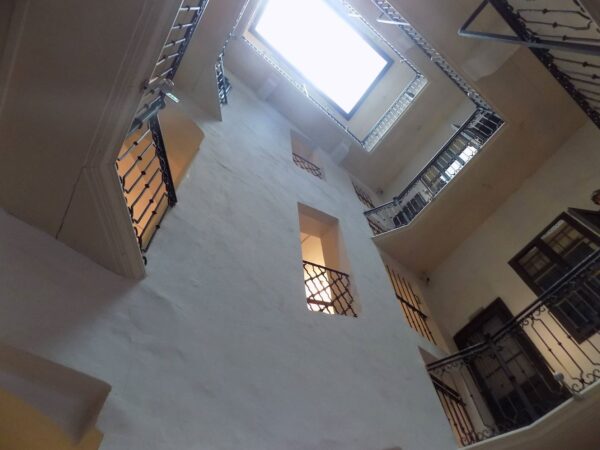
where Mozart, Constanze, and one of their two surviving sons, Karl Thomas, lived for about two and a half years from September 1784 to April 1787. (Karl Thomas, whose birthdate was 21 September 1784, might have been born in this apartment. His brother Johann Thomas lived less than a month and would have certainly been born and died in this apartment.)
Generally, photos aren’t allowed although I did sneak a few even if they don’t show you very much. Instead, you can watch this video produced by the museum.
There’s more Vienna to explore in the next post and I promise a deeper look at Nannerl and Salieri later in this journal plus, I’ll do a little more Mozart myth busting before we leave Austria.